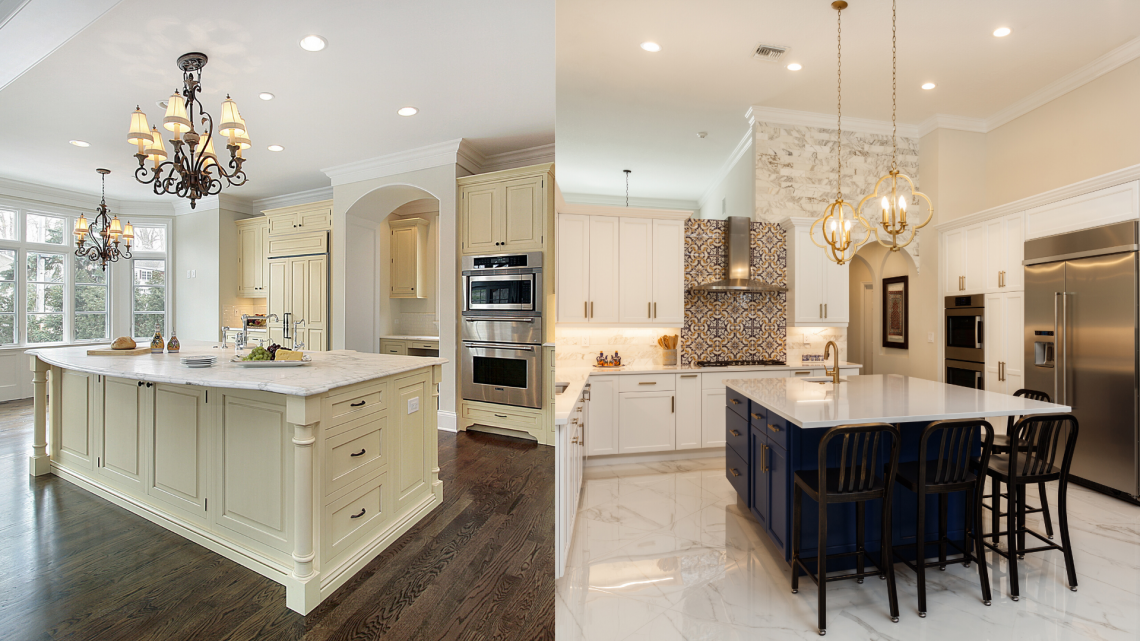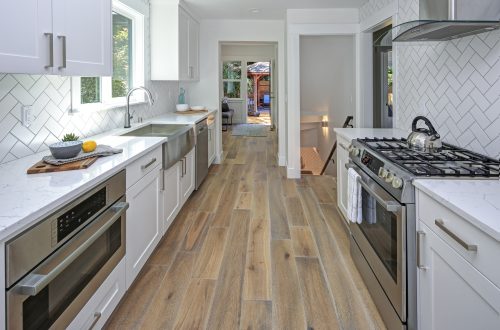
Hardwood vs. Tile in the Kitchen
Hardwood in the kitchen is one floor covering many home owners are hesitant about installing. Lately, however, more and more clients have been opting for hardwood installed in their kitchen and we are very excited for this.
Hardwood flooring in kitchens are extremely popular in the Northeast. Hardwood floors rank higher among clients for the preferred flooring choice than tile flooring. We fully understand why. While tile is extremely durable, it is often hard and unforgiving on your feet. And a home with an active family where dishes are a constant, the desire for a softer floor on your feet is a must- and hardwood allows for that.
Tile is very popular down here is Texas. With the Texas heat, tile helps keep your home cooler. But, it dates much faster than hardwood floors. Hardwood floors are timeless and classic. I’ve never heard anyone say, “wow that hardwood is dated.” While stain and color trends go in and out of style, hardwood offers the benefit of sanding to keep up with the current stain trends. Tile dates and if you have an outdated tile style installed in your home, it can make your home’s décor feel older than it is.
Tile is very water resilient. You can worry less about tile floors in the kitchen than hardwood. Hardwood requires a bit more maintenance than tile especially when installed in the kitchen area. Water and hardwood are not friends. Hardwood buckles and can damage when introduced to water. Water typically has no effect on tile floors except when seeped into the subfloor and the subfloor is incorrect (i.e. a plywood subfloor.) If tile is installed on a plywood subfloor, you will have issues with wter and moisture.
Grout joints vs hardwood planks and spacing is another consideration to be taken into account. The most popular type of grout is cement base. Cement base grout is extremely porous and a magnet for dirt, grime and stains. You’ll notice that in time, your grout color will change and probably darken. That is from dirt, grime, etc. Cleaning grout is often difficult and time consuming. This can be prevented by sealing your kitchen grout but it is not a one-time application. You’ll need to seal your grout about every 6 months to avoid it staining from dirt. Hardwood planks will have small spaces where dirt can build up. This can be easily managed with a wood floor vacuum. It’s much easier to clean than grout.
If you decide on a wood floor for your kitchen, seriously consider a site finished floor. A site finished floor is when a skill floor professional will apply the finish once the floor have been installed and sanded. Site finish floors offer more benefits than a prefinished floor because the product the finisher uses will seep into all areas of the hardwood- including the seams.
If your floor is damaged, hardwood is much easier to fix. Tile styles are often discontinued or out of stock, and if they haven’t been disco’d but purchased at different times(especially from different stores or months/years part) the coloring and overall style will be different. Many times, tile floors can not be a patch fix. Rather most if not all of the flooring needs to be replaced. The beauty of hardwood is the ability to repair a damage section with a weave in process. Now, the color of the new floor will vary from the existing hardwood, but that can be adapted by staining a darker color. At some point, the new floor will oxidize and catch up to the existing floors color.
While I can’t tell you which flooring is best, because that is completely up to your needs, I can tell you hardwood offers a few more advantages than tile. I especially love the timelessness of wood floors vs tile; the softness on your feet and the overall look of hardwood in the kitchen.





6 Comments
Pingback:
Pingback:
Pingback:
Pingback:
Pingback:
Pingback: